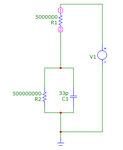HugeFanOfBadReligion
Newbie level 2
Hey guys,
I have two resistors in series and to one of the resistor there is a capacitor connected in parallel. I have some questions about the current flowing in the circuit.

1. If i put a step voltage on the input, the current starts to flow through the first resistor and then it starts to charge the capacitor. Does that mean that in the very first moment during the voltage step the current flows only through the first resistor R1 to the ground? The current through the parallel resistor branch is therefor zero?
2. After some time the capacitor is charging exponentially. That means the voltage will change exponentially and so the current starts to flow in the parallel resistor branch also in exponential time course, am i correct?
3. If i will measure the total current in the node connected to the ground, will i observe the exponentially decaying current with some deviation from the mono-exponential function (due to the summation of the currents from both branches of my parallel network)?
4. what is the time constant of such decay? Is it just: tau=C1x(R1xR2/(R1+R2)) . Why not just C1xR2?
Thank you for your Answer
I have two resistors in series and to one of the resistor there is a capacitor connected in parallel. I have some questions about the current flowing in the circuit.

1. If i put a step voltage on the input, the current starts to flow through the first resistor and then it starts to charge the capacitor. Does that mean that in the very first moment during the voltage step the current flows only through the first resistor R1 to the ground? The current through the parallel resistor branch is therefor zero?
2. After some time the capacitor is charging exponentially. That means the voltage will change exponentially and so the current starts to flow in the parallel resistor branch also in exponential time course, am i correct?
3. If i will measure the total current in the node connected to the ground, will i observe the exponentially decaying current with some deviation from the mono-exponential function (due to the summation of the currents from both branches of my parallel network)?
4. what is the time constant of such decay? Is it just: tau=C1x(R1xR2/(R1+R2)) . Why not just C1xR2?
Thank you for your Answer